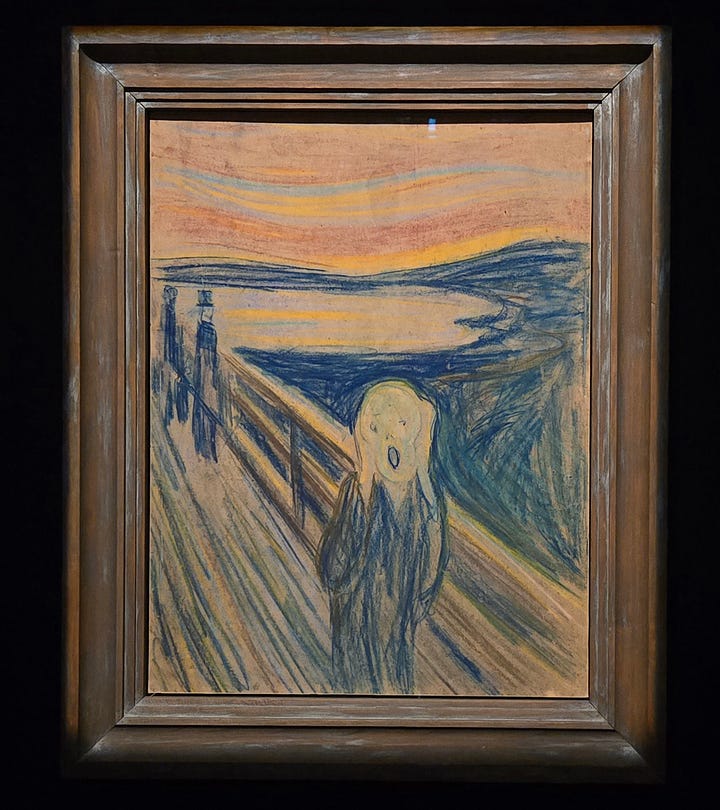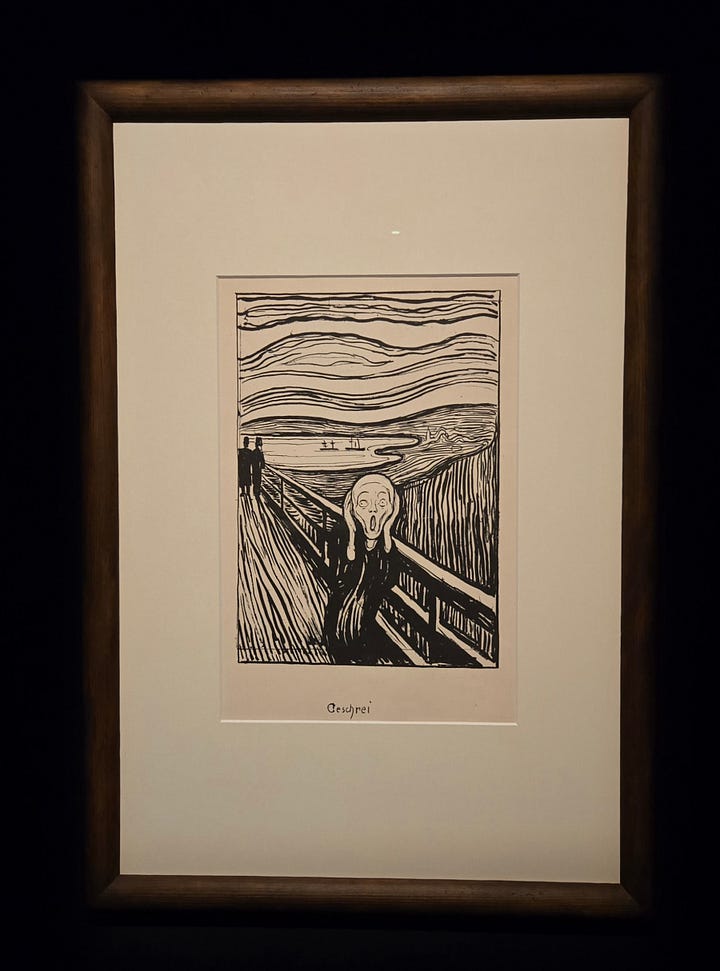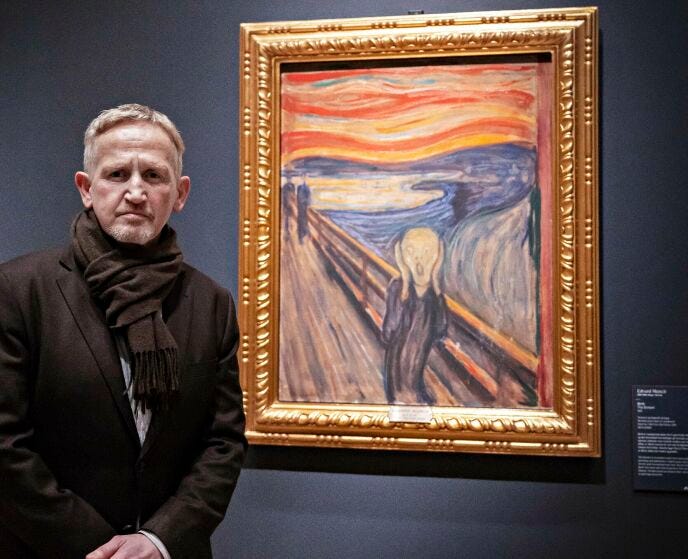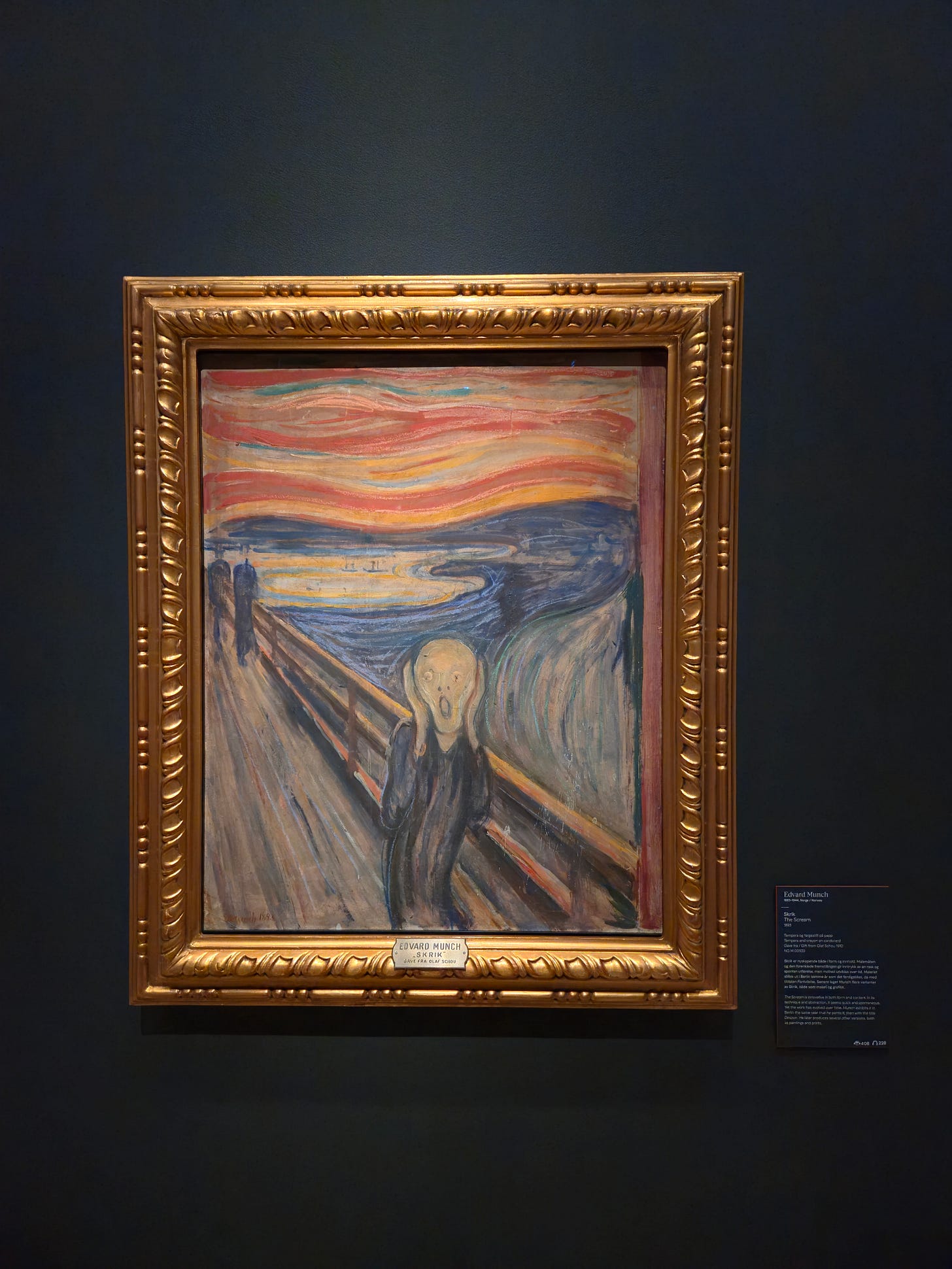The footballer who stole The Scream
Once a promising footballer, Pål Enger became the mastermind behind the theft of one of the world’s most iconic masterpieces during the 1994 Olympics.
Welcome to Sports Politika, a media venture founded by investigative journalist and researcher Karim Zidan that strives to help you understand how sports and politics shape the world around us. My mission is to offer an independent platform for accessible journalism that raises awareness and empowers understanding.
If you share this vision, please consider supporting my work by joining becoming a paid subscriber. I am currently running a special offer whereby you can secure a subscription at a 40% discounted price…forever.
On a cool, drizzly Sunday in May 2025, I visited MUNCH, the museum dedicated to the life and works of the Norwegian artist Edvard Munch (1863-1944)—best known for arguably the most famous painting in the world, The Scream.
Located along the waterfront in the beautiful Norwegian capital of Oslo, the museum houses well over half of the artist’s entire production of paintings and at least one copy of all his prints. This amounted to over 1,200 paintings, 18,000 prints, six sculptures, as well as 500 plates, 2,240 books, and various other items. Spread across 13 floors, the museum is considered to be one of the largest single-artist museums in the world.
The various versions of The Scream—a painting, a drawing and a print—were housed in their own dimly-lit room in the museum. Since Munch had created each version on either cardboard or paper, they were more fragile than oil paintings on canvas. Therefore, the works alternated every 30 minutes; one is always visible while the other two others rest in darkness.


Munch’s work is unique, evocative, and in some cases, irresistible to thieves. In fact, The Scream has been stolen twice. A version of the painting was stolen from the National Gallery in Oslo during the 1994 Winter Olympics in Lillehammer, when two men needed just 50 seconds to steal one of the most famous paintings in history. Adding insult to injury, the thieves left a note scribbled on the back of a postcard that read: “Thanks for the poor security.”
At the time, the theft was a national scandal. The treasured masterpiece had been stolen during the opening ceremony for the Winter Games, adding to the host country’s embarrassment. A manhunt ensued to find The Scream.
The mastermind behind the theft was Pål Enger, a former professional footballer-turned-criminal. Enger grew up in the impoverished Tveita district in Oslo, where sports served as his only distraction from crime, drugs, and the violence he suffered at the hands of an abusive stepfather. He made his mark as a talented footballer and began playing professionally for Norwegian side Vålerenga in 1985.
Despite his rising prospect in football, Enger couldn’t resist the lure of the criminal underworld. As a child, he was obsessed with Frances Ford Coppola’s mobster epic The Godfather, and soon tried his hand at petty theft before graduating to stealing jewels and blowing up ATMs. His penchant for crime remained a fixture in his life, even as a footballer. His teammates admitted he would steal fancy cars to drive to practice. Eventually, the rewards from his crimes outpaced his incentives to compete.
Enger’s other obsession was The Scream, which he first encountered during a school trip. He became enraptured by the work, which, to him, embodied the trauma he had endured growing up. Years later, his obsession with the work remained intense, and he resigned himself to stealing the work and making it his own.
In 1988, he made his first attempt to steal The Scream. However, a miscalculation about the point of entry landed him in front of another of Munch’s celebrated works, Vampire, and he decided to steal that instead. Though initially disappointed, Enger decided to keep the painting, hiding it in the ceiling of a pool hall he had bought that had become a local spot for off-duty police.
“‘They don’t know it’s hanging just one meter from them,” Enger said in The Man Who Stole The Scream documentary about the heist, “That was the best feeling. We let them play for free just to have them there.”
Enger’s euphoria did not last. He was arrested and sentenced to four years in prison after his co-conspirator revealed the work’s location to a confidential informant. He subsequently spent his time locked away plotting the heist that would serve as the culmination of his criminal career.
As the world watched the opening ceremony of the 1994 Olympics in Lillehammer, a homeless man and his associate—paid by Enger—proceeded to steal one of the world’s most famous artworks in less than a minute.
“I was so happy,” Enger recalled in the documentary. “I felt the power.”
Given his track record with stealing Munch masterpieces from the national museum, the police naturally suspected Enger for the latest, most significant, heist. Nevertheless, Enger was certain that the police had no actual evidence against him. When his son was born a few weeks later, he took out an ad in the newspaper announcing that his first-born son had come into this world “with a scream.” He would call to harass the police and even left anonymous tips that the painting was in his car, only to delight in the baffled looks of the officers when they come up empty-handed.
Eventually, Norway sought international support and brought in crime units from various countries. It was an officer from Scotland Yard who eventually cracked the case after going undercover as an art dealer and meeting with the thief that Enger had hired. After the thief was apprehended during the exchange, Enger was arrested and charged with gun offences and, despite the initial lack of evidence, the theft of The Scream. He was sentenced to six-and-a-half years in prison, the longest sentence at the time for such a crime.
The Scream, meanwhile, was returned to its home in the National Gallery, where it remained for another decade before being stolen once again in 2004—this time along with Madonna and another of Munch’s works. Before the paintings were recovered, Enger was questioned by police, who naturally suspected his involvement; however, he was not connected to the theft. The works were eventually recovered later that year, and The Scream now hangs in the new National Museum, overlooking the water. Three other versions—Munch was famously fond of creating multiple iterations of his masterpieces—are housed in the dedicated MUNCH Museum, protected under stringent security.
Nevertheless, while museums around the world upgraded their security to better protect against art thefts, thieves continue to confound these renowned establishments using little more than stairs and some power tools. This is what happened at the Louvre in Paris, France this week when four thieves reached the second-floor balcony of the museum and stole priceless artifacts from the collection of crown jewels and was built in 1661 by Louis XIV. Last month, criminals broke into Paris’s Natural History Museum, making off with gold samples worth $700,000.
The Louvre itself has a storied history of thefts, most famously in 1911 when an Italian decorator who disguised himself as a museum worker stole the Mona Lisa in broad daylight.
As for Enger, he served his time, renounced crime, and enjoyed life a celebrity. He was featured in documentaries and television series and even became a painter himself. He passed away in 2024 at the age of 57, less than a year after appearing in the acclaimed documentary “The Man Who Stole The Scream.”
While Enger was never quite able to explain exactly what compelled him to steal The Scream, he never seemed to regret his decision. In this final interview in the 2023 documentary, he embraced his role as the man who pulled off one of the most sensational art heists of the 20th century.
“I made history and it’s a cool story,” he said.
Sports Politika is a media platform focusing on intersection of sports, power and politics. Support independent journalism by upgrading to a paid subscription ( or gift a subscription if you already have your own). We would appreciate if you could also like the post and let us know what you think in the comment section below.




